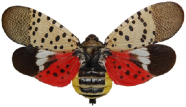
Spotted Lanternfly Spots
By: Julie Barnes, Master Gardner
The spotted lanternfly is heavily showing its spots here in Western PA. Swarms of this invasive pest have been reported in Monroeville, Murrysville, Greensburg, McKeesport, and North Hills with large concentrations in Downtown Pittsburgh and the North Shore. Here are some quick facts and websites.
- • Spotted lanternflies are not flies and don't bite, or sting people. They are related to insects that include cicadas, stink bugs, aphids, and leafhoppers. Being plant hoppers with voracious appetites, they suck the juices from plants. The invasive weed, Tree of Heaven, Ailanthus altissimia, https://extension.psu.edu/tree-of-heaven that was once widely planted as a valuable urban state tree is their favorite host plant. Spotted lanternflies also feed on roses, grapevines, maples, walnuts, birch, willows, sumac, and other ornamentals.
- • When spotted lanternflies feed, they excrete a sugary substance, called honeydew. As it rains down and sticks to surfaces, wasps, bees and other insects are attracted. A honeydew coating also encourages black sooty mold growth that is harmless to people, but damages plants, stains decks, cars and other outside surfaces. https://extension.psu.edu/spotted-lanternfly
- • Spotted lanternflies go through three different life stages; Eggs overwinter, nymphs emerge in spring, nuisance adults appear in July/August to cover trees, swarm in the air, and shower decks and recreation equipment with honeydew. After mating in the fall, Spotted Lanternflies deposit egg masses with 30-50 eggs, protected by a mud-like covering, on the sides of trees, pallets, firewood, outdoor furniture, and other flat objects. Spotted lanternfly adults do not hibernate and are active until killed by hard fall freezes. https://extension.psu.edu/have-you-seen-a-spotted-lanternfly
- • Spotted lanternflies are native to China and were first discovered in the United States in 2014 in Berks County, Southeastern PA. Spottings in Western PA were as early as 2019, but their populations were relatively small and scattered. However, these numbers grew significantly this summer locally. The Spotted Lanternfly quarantine has been in place to protect Pennsylvania's economy, residential quality of life, and to stop this invasive pest from spreading to new areas within, or outside current quarantine zones. Quarantine zones are expanded to new areas when Spotted Lanternfly detections are confirmed. In 2023, six more counties were added. Now, 51 out of PA's 67 counties are listed under quarantine for Spotted Lanternflies. https://www.agriculture.pa.gov/Plants_Land_Water/PlantIndustry/Entomology/spotted_lanternfly/quarantine
- • When you spot an adult spotted lanternfly stomp on it from the front, since Spotted Lanternflies can only jump forward. Adults only have wings to fly. However, they walk more than fly. Their wings often remain closed, making it difficult to identify them. Reachable egg masses can also be destroyed by scraping them off trees, or other surfaces, to immediately submerge into alcohol, or hand sanitizer. Although Spotted Lanternflies appear to be everywhere, residents are still asked to report sightings, so researchers can better understand this insect for control methods. A 2019 economic impact study estimated that this insect, uncontrolled, could cost the state $324 million annually. To report a lanternfly sighting, call 1-888-4BAD-FLY (1-888422-3359) or visit https://services.agriculture.pa.gov/SLFReport/
- • Interestingly, honey bees were found to be gaining weight after their foraging period in Spotted Lanternfly quarantine areas. These bees produced a smoky flavored dark honey. DNA analysis found it contained Tree of Heaven DNA, the favorite Spotted Lanternfly host. The bees feeding on this excreted honeydew were found to be healthy while the smoky honey is being produced and used by different businesses. Another curious point is that the milkweed, essential to monarch butterflies, may be deadly to Spotted Lanternfly nymphs and adults that ingest it.